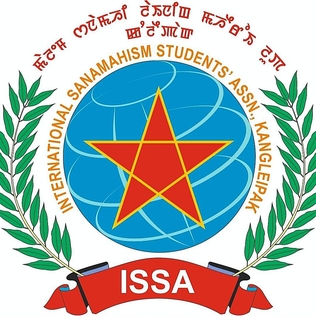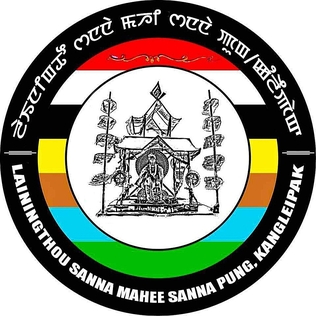
The Meitei people, also known as the Manipuri people, is the predominant ethnic group of Manipur in Northeast India. They speak Meitei language, one of the 22 official languages of the Indian Republic and the sole official language of Manipur. The Meiteis primarily settled in the Imphal Valley region in modern-day Manipur, though a sizable population has settled in the other Indian states of Assam, Tripura, Nagaland, Meghalaya, and Mizoram. There is also a notable presence of Meitei in the neighboring countries of Myanmar and Bangladesh. The Meitei ethnic group represents about 53% of Manipur's population.

Sanamahism or Meiteism or Lainingthouism, is an ethnic religion of the Meitei people of Manipur, Northeast India. It is a polytheistic religion and is named after God Lainingthou Sanamahi, one of the most important deities of the Meitei faith. Sanamahi is the eldest son of the supreme god Yaibirel Sidaba and the supreme goddess Leimarel Sidabi. Traditionally every Meitei household, irrespective of the religion, worships Sanamahi and Leimarel Sidabi. The importance of Sanamahi in the religion is also emphasized in the name itself which means Liquid Gold. Sanamahism does not have a religious head but has a body, Maru Loishang that oversees the main religious activities and govern all affairs pertaining to the religion including conducts of priest and priestess. The Maru Loishang also acts a court for religious disputes. There are three main departments under the Pandit Loishang, namely, the Amaiba Loishang, the Pena Asheiba Loishang and the Amaibi Loishang. These departments have existed since the reign of King Meidingu Hongnemyoi Khunjao Naothingkhong of Manipur in 662 AD.

The Sanamahi creation myth is the traditional creation myth of Sanamahism, a religion of the Meitei, Chothe, Komhreng, Kabui, Anāl, and, before their conversion to Christianity, Tangkhul people in Manipur, India.
Laininthou Sanamahee is the Supreme Guardian God of mankind and the supreme deity of the household in Meetei religion and mythology. He originated from the ancient kingdom of Kangleipak (Manipur). He is regarded as the most popular and significant divinity of Sanamahism. He is the brother of Pakhangba and Nongshaba. He is the eldest son of Creator God Saalailel Sitapa and Leimalel Sitapee, the protector of the Universe in Meetei mythology and philosophy and Mother Earth goddess Leimarel Sidabi.

Nongshaba, also spelled as Nongsaba, is a Lion God in Meitei religion (Sanamahism) and mythology. He is also regarded as a king of the gods. He is credited with producing light in the primordial universe and is regarded as the maker of the sun. He is worshipped by the people of both the Ningthouja clans as well as the Moirang clans. God Nongshaba was worshipped by the people of Moirang clan as a lineage deity and regarded as the father of God Thangching (Thangjing). He is the greatest of the Umang Lais in Ancient Kangleipak but he made his only son Thangching (Thangjing) the chief deity of Moirang.

Meitei deities are the deities affiliated to Meitei mythology and Meitei religion (Sanamahism) of the Meitei people of Manipur. Among many gods, main Meitei gods are Atingkok, Asheeba (Sanamahi) and Apanba (Pakhangba). Among many goddesses, main Meitei goddesses are Leimarel Sidabi, Imoinu (Emoinu), Panthoibi and Phouoibi (Phouleima).
Sanamahi Ahong Khong Chingba or Sanamahi Cheng Hongba or Kang Chingba is the religious festival of Meitei people, associated mainly with the public procession with the grand chariot, housing the ancient Meitei deity Lainingthou Sanamahi. The Imphal city serves as the main location of the festival. It attracts thousands of pilgrims who join the procession. The festival was celebrated 350 years ago, and after a long pause, it was first recelebrated in the year 2018.

Hinduism is one of the religions practiced in the state of Manipur, India. Hinduism is concentrated in the Imphal Valley and other plain districts of Manipur located in the regions neighbouring Assam state. Hinduism is practiced mostly among the Meitei people, who are the predominant ethnic group of Manipur. Whilst the proportion of Manipur's population that practices Hinduism is roughly 41%, in the Manipur valley region Hindus constitute as much as 67-74% of the population.

Meitei Hindus or Manipuri Hindus are the adherents of Hinduism and are native to Manipur kingdom and the South East Asian regions. Meitei Hindus speak Meitei language, which belongs to the Sino-Tibetan language family and adhere to the Vaishnava section of their religion, Hinduism.
The Nongmaiching Ching, also known as the Selloi Langmai Ching, is a mountain in Imphal Valley, Manipur. It has an altitude of around 5,133 feet (1,565 m). It is a holy pilgrimage site for the Meitei people. In Meitei mythology and religion (Sanamahism), it is a sacred mountain and the abode of God Nongpok Ningthou and Goddess Panthoibi. In Meitei folklore, the Nongmaiching is described as the hill that produces "the seven days of a week".

The Lainingthou Sanamahi Kiyong, officially known as the Laiyingthou Sanamahi Kiyong, is a temple of God Lainingthou Sanamahi of Meitei religion (Sanamahism), built on the Nongmaiching mountain in the Imphal East district of Kangleipak. It is a center of the Sanamahism followers in Manipur. It is the central body of the "Sanamahi Lainingkol" at Chingoi Maru Langmaiching (Nongmaiching).

The Lainingthou Sanamahi Temple Board (LSTB) (Meitei: /lāi-nīng-thou sa-nā-ma-hī lāi-sang lūp/) is a temple development board of the Lainingthou Sanamahi Temple, Haying Khongban Uphong Yumpham, Imphal West district of Kangleipak (Manipuri for 'Manipur'). It is dedicated not only to God Lainingthou Sanamahi and Goddess Leimarel Sidabi of Sanamahism, but also to the other ancient Meitei gods and goddesses of the traditional Meitei religion.

The International Sanamahism Students' Association (ISSA) (Meitei: Malem Sanamahi Laining Maheiroi Lup), also called the International Sanamahism Students' Association, Kangleipak (Meitei: Malem Sanamahi Laining Maheiroi Lup, Kangleipak), is an international non-governmental organization of students of Sanamahism (traditional Meitei religion). It gives its services to the conservation and the upraising of the practices of Sanamahism in the society. It also draws the attention to the government of Manipur state to take up essential steps to protect Sanamahism from getting extinct.

The Lainingthou Sanna Mahee Sanna Pung, Kangleipak, also known as the Lainingthou Sanamahi Sanapung (LSSP), is a non-governmental organization of the followers of the Sanamahism, dedicated to God Lainingthou Sanamahi and other ancient Meitei deities of Kangleipak.

The South East Asia Cultural Organisation (SEACO) is an international cultural organization that works for the development of the Meitei culture of Kangleipak (Manipuri for 'Manipur'). It aims to preserve the unique history, culture, identity and religion of Manipur. It also advocates to take "extra caution about the issue of preservation of the cultural identity of the indigenous people in the wake of the present globalization".

Medieval Kangleipak or Medieval Manipur refers to a long period of history of Manipur between the "ancient period" and the "modern period". It encompasses the 15th century AD to the 19th century AD.

The Meitei scriptures are a number of books and other texts which tell about Meitei religion (Sanamahism) as well as Meitei mythology. They are the sacred literature for the Meitei pagans. Notably, one should not confused all the Puya to be Meitei scriptures, because many puyas were written based on the topics irrelevant to religion.

The culture of Meitei civilization evolved over thousands of years, beginning in Ancient Manipur, continuing most notably into Medieval Manipur, while influencing the neighboring states and kingdoms.

Meitei festivals are an integral part of the cultural heritage of the Meitei people, an ethnic group native to the Indian state of Manipur. The festivals often celebrate events from Ancient Manipur and often coinciding with seasonal changes. These festivals reflect the unique customs and traditions of the Meitei community, and are celebrated with great enthusiasm and zeal. There are various festivals celebrated throughout the year, each with its own significance and rituals.

The Meitei Manipuri philosophy or Kanglei Meetei philosophy refers to the philosophical traditions of Ancient Manipur. In 15th century BC, the Wakoklon Heelel Thilel Salai Amailon Pukok Puya, one of the foremost and the oldest Meitei scriptures based on the antique philosophical traditions, was written in Ancient Manipur. It is the basis of the ideology of Sanamahism, the primitive Meitei religion. In early notions, the ideology of the creation myth has strong connection with the shapes and figures of the Meitei numerals and Meitei script letters. The philosophical norms are inscribed in the massive materials of many ancient Meitei chronicles.













